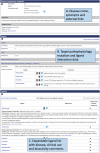The IUPHAR/BPS Guide to PHARMACOLOGY in 2020: extending immunopharmacology content and introducing the IUPHAR/MMV Guide to MALARIA PHARMACOLOGY
- PMID: 31691834
- PMCID: PMC7145572
- DOI: 10.1093/nar/gkz951
The IUPHAR/BPS Guide to PHARMACOLOGY in 2020: extending immunopharmacology content and introducing the IUPHAR/MMV Guide to MALARIA PHARMACOLOGY
Abstract
The IUPHAR/BPS Guide to PHARMACOLOGY (www.guidetopharmacology.org) is an open-access, expert-curated database of molecular interactions between ligands and their targets. We describe significant updates made over the seven releases during the last two years. The database is notably enhanced through the continued linking of relevant pharmacology with key immunological data types as part of the IUPHAR Guide to IMMUNOPHARMACOLOGY (www.guidetoimmunopharmacology.org) and by a major new extension, the IUPHAR/MMV Guide to Malaria PHARMACOLOGY (www.guidetomalariapharmacology.org). The latter has been constructed in partnership with the Medicines for Malaria Venture, an organization dedicated to identifying, developing and delivering new antimalarial therapies that are both effective and affordable. This is in response to the global challenge of over 200 million cases of malaria and 400 000 deaths worldwide, with the majority in the WHO Africa Region. It provides new pharmacological content, including molecular targets in the malaria parasite, interaction data for ligands with antimalarial activity, and establishes curation of data from screening assays, used routinely in antimalarial drug discovery, against the whole organism. A dedicated portal has been developed to provide quick and focused access to these new data.
© The Author(s) 2019. Published by Oxford University Press on behalf of Nucleic Acids Research.
Figures








References
-
- Pawson A.J., Sharman J.L., Benson H.E., Faccenda E., Alexander S.P.H., Buneman O.P., Davenport A.P., McGrath J.C., Peters J.A., Southan C. et al. .. The IUPHAR/BPS Guide to PHARMACOLOGY: an expert-driven knowledgebase of drug targets and their ligands. Nucleic Acids Res. 2014; 42:D1098–D1106. - PMC - PubMed
Publication types
MeSH terms
Substances
Grants and funding
LinkOut - more resources
Full Text Sources

